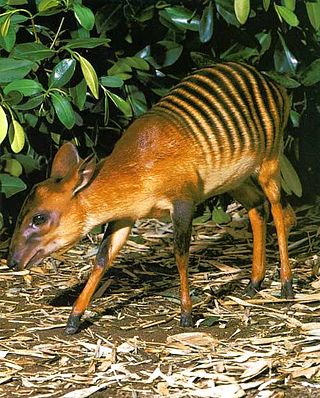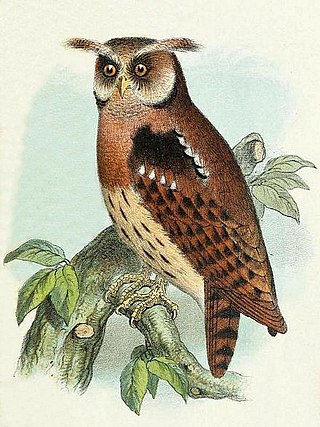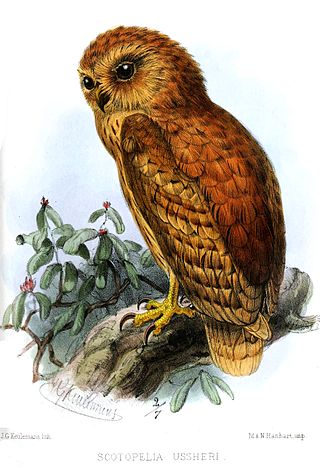
The African palm civet, also known as the two-spotted palm civet, is a small feliform mammal widely distributed in sub-Saharan Africa. It is listed as least concern on the IUCN Red List.

Taï National Park is a national park in Côte d'Ivoire that contains one of the last areas of primary rainforest in West Africa. It was inscribed as a World Heritage Site in 1982 due to the diversity of its flora and fauna. Five mammal species of the Taï National Park are on the Red List of Threatened Species: pygmy hippopotamus, olive colobus monkeys, leopards, chimpanzees, and Jentink's duiker.

The king colobus, also known as the western black-and-white colobus, is a species of Old World monkey, found in lowland and mountain rainforests in a region stretching from Senegal, through Guinea-Bissau, Guinea, Sierra Leone and Liberia to the Ivory Coast. One of five members of the genus Colobus, the black-and-white colobuses, the king colobus is the westernmost species of the group on the continent of Africa. It eats mainly leaves, but also fruits and flowers. Though it is arboreal, it eats primarily on the ground. It lives in small groups consisting of 3 to 4 females and 1 to 3 males, plus their young. These groups maintain distance from one another through territorial calling.

The zebra duiker is a small antelope found primarily in Liberia, as well as the Ivory Coast, Sierra Leone, and occasionally Guinea. They are sometimes referred to as the banded duiker or striped-back duiker. It is believed to be one of the earliest duiker species to have evolved.

The wildlife of Ivory Coast consists of the flora and fauna of this nation in West Africa. The country has a long Atlantic coastline on the Gulf of Guinea and a range of habitat types. Once covered in tropical rainforest, much of this habitat has been cleared, the remaining terrain being gallery forests and savanna with scattered groups of trees, resulting in a decrease in biodiversity. As of 2016, 252 species of mammal had been recorded in Ivory Coast, 666 species of bird, 153 species of reptile, 80 species of amphibian, 671 species of fish and 3660 species of vascular plant.
Didelotia idae is a species of plant in the family Fabaceae. It is found in Ivory Coast, Ghana, Liberia and Sierra Leone. It is threatened by habitat loss. The wood of the species is traded under the name 'Gombe'.

Acanthixalus sonjae is a species of frog in the family Hyperoliidae. It is found in south-western Ivory Coast and in south-western Ghana, and possibly in adjacent Liberia.
The brown-cheeked hornbill is a species of hornbill in the family Bucerotidae. It is found in Ivory Coast, Ghana, Guinea, Liberia, Sierra Leone, and Togo. Its natural habitats are tropical and subtropical moist broadleaf forests, plantations, and secondary growth forests. It is threatened by habitat destruction, as timber is harvested and the forests become increasingly fragmented.

The maned owl or the Akun scops owl, is a species of owl in the family Strigidae that is endemic to Africa. It is the only species in genus Jubula.

The rufous fishing owl, rufous-backed fishing-owl or Ussher's fishing owl, is a species of owl in the family Strigidae. It is endemic to west Africa, where it is a highly localised resident along forest rivers.

The white-headed wood hoopoe is a species of bird in the family Phoeniculidae.

The halcyon horseshoe bat is a species of bat in the family Rhinolophidae. It is found in Cameroon, Republic of the Congo, Democratic Republic of the Congo, Ivory Coast, Equatorial Guinea, Ghana, Guinea, Kenya, Liberia, Nigeria, Senegal, South Sudan, Togo, Uganda, possibly Gabon, and possibly Sierra Leone. Its natural habitats are subtropical and tropical dry and moist lowland forest, moist savanna, caves, and other subterranean habitats.

Zenker's fruit bat or Tear-drop bat is a species of megabat in the family Pteropodidae. Its natural habitats are tropical and subtropical moist broadleaf forests and swamps.
Albizia ferruginea is a species of plant in the family Fabaceae. It is found in Angola, Benin, Burkina Faso, Cameroon, Central African Republic, the Republic of the Congo, the Democratic Republic of the Congo, Ivory Coast, Gabon, Gambia, Ghana, Guinea, Guinea-Bissau, Nigeria, Senegal, Sierra Leone, Togo, and Uganda. It is threatened by deforestation
Milicia regia is a species of tropical tree in the family Moraceae. It grows in a belt on the west coast of Africa that extends from the Gambia to Ghana. It is threatened by habitat loss and logging.
Protomegabaria stapfiana is a species of plant in the family Phyllanthaceae. It is native to western tropical Africa.

Parinari excelsa, the Guinea plum, is a species of large, evergreen tree in the family Chrysobalanaceae. It has a very wide distribution in tropical Africa and the Americas. This species grows to 50 m (160 ft) tall while the trunk is up to 1.5 m (5 ft) in diameter.
Cynometra ananta is a perennial large tree within the Fabaceae family. Its timber is traded under the name Apome in Ivory Coast and Ananta in Ghana.
Anthonotha fragrans is a medium to large sized tree commonly found in the rainforest environments of West and Central Africa; it belongs to the Fabaceae family. Its sapwood exudes a white to creamy exudate.
Brachystegia leonensis is a medium to tall sized tree occurring in the rain forests of West Africa, belonging to the family Fabaceae. It is one of three species within the genus Brachystegia that is represented in West Africa. It is morphologically close to Brachystegia kennedyi, a species occurring in Nigeria.











